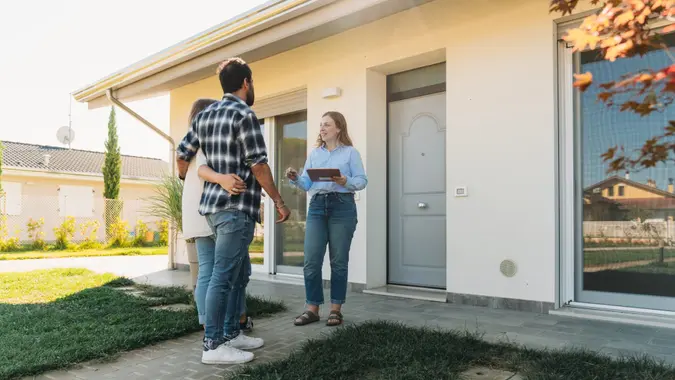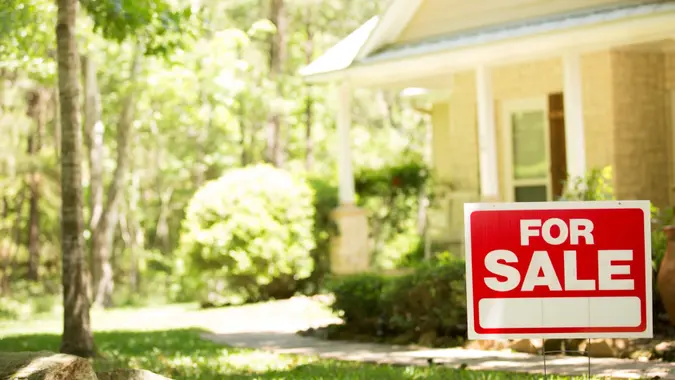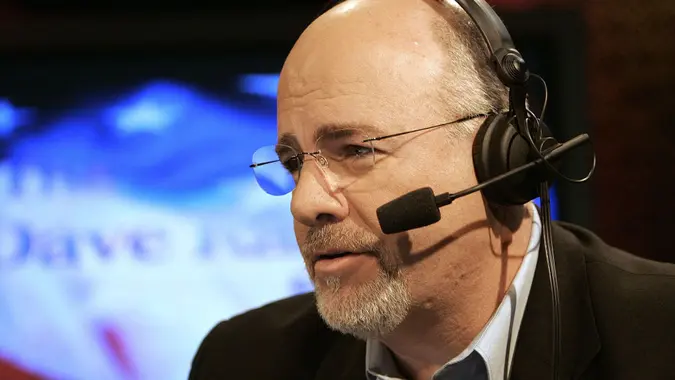How Much Does It Cost To Buy Down Your Interest Rate?

Commitment to Our Readers
GOBankingRates' editorial team is committed to bringing you unbiased reviews and information. We use data-driven methodologies to evaluate financial products and services - our reviews and ratings are not influenced by advertisers. You can read more about our editorial guidelines and our products and services review methodology.

20 Years
Helping You Live Richer

Reviewed
by Experts

Trusted by
Millions of Readers
If you’re buying a home or refinancing, you’ve probably heard the term “buy down interest rate” tossed around. But what does it actually mean — and more importantly, how much does it cost?
In short, buying down your interest rate means paying upfront to lower your mortgage rate and monthly payments. The trade-off? A bigger bill at closing in exchange for savings over time.
This strategy can be a smart money move, especially in a high-rate environment. Let’s break it down simply so you can decide if it’s worth it for you.
What Does It Mean To Buy Down an Interest Rate?
When you buy down your interest rate, you’re paying a fee upfront to get a lower mortgage rate for your loan. This fee is paid in what’s called mortgage points — also known as discount points. According to the IRS, mortgage points may be deductible as mortgage interest if certain conditions are met
Each point costs 1% of your loan amount and typically reduces your rate by around 0.25%.
Example: On a $300,000 loan, 1 point = $3,000 and could drop your rate from 7% to 6.75%.
Why People Do It
Freddie Mac reports that as of July 2025, the average 30-year fixed mortgage rate is 6.95%, making buydowns an increasingly relevant option for borrowers.
Lower rates mean smaller monthly payments and thousands of dollars saved in interest over time. But you’ll need to pay more upfront to get there.
Why Buy Down Your Interest Rate?
Here’s what you gain when you buy down your interest rate:
Lower Monthly Payments
A lower rate means smaller monthly payments, which frees up your budget. That could mean more money for savings, home upgrades or debt payments.
A 0.5% rate reduction on a $300,000 loan can lower your monthly payment by around $90 to $100.
Long-Term Interest Savings
The real magic happens over time. Buying down your rate can lead to significant long-term savings. On a $300,000, 30-year loan, lowering your rate from 7% to 6.5% could save you over $30,000 in interest.
Possible Tax Perks
In many cases, mortgage points are tax-deductible as mortgage interest. That could give you an extra boost at tax time, especially in the first year of your loan. Just be sure to check with a tax professional.
So, How Much Does It Cost To Buy Down an Interest Rate?
To properly get to the bottom of that, there are a few factors we’ll need to dig into.
Mortgage Points Explained
- 1 point = 1% of your loan amount
- Each point = approx. 0.25% rate reduction
If your loan is $300,000:
- 1 point = $3,000
- 2 points = $6,000
Your Break-Even Point
This is the key to knowing if it’s worth it: How long will it take for your monthly savings to equal the upfront cost?
Example:
- You spend $6,000 on points
- You save $100 per month on your mortgage
- Your break-even = 60 months, or five years
The Consumer Financial Protection Bureau recommends using a mortgage calculator to determine if paying points makes financial sense.
Types of Buydowns: Permanent vs. Temporary
There are two key types of buydowns you’ll need to keep in mind. Let’s dig into them a bit deeper:
Permanent Buydown
You pay points upfront to lock in a lower rate for the entire life of your loan. This is a good option if you’re planning to stay in your home for a long time.
Temporary Buydowns
With a temporary buydown, your rate starts low and gradually increases to the full rate.
2-1 Buydown
- Year 1: Interest rate reduced by 2%
- Year 2: Rate reduced by 1%
- Year 3+: Standard interest rate applies
3-2-1 Buydown
- Year 1: Reduced by 3%
- Year 2: Reduced by 2%
- Year 3: Reduced by 1%
- Year 4+: Standard rate kicks in
Many builders and sellers offer temporary buydowns to attract buyers.
How To Buy Down Your Interest Rate
Now that we know all those details, let’s get into how to do it. Here’s a step-by-step guide:
1. Check Your Budget First
Make sure you have enough cash to cover the cost of the buydown, without draining your emergency savings or cutting into your move-in budget.
2. Compare Lenders
Not all lenders offer the same rate reductions per point. Shop around to see which lender gives you the best return on your upfront investment.
3. Ask the Seller or Builder to Chip In
In today’s market, some sellers and builders may offer to pay for part or all of the buydown as an incentive. Always ask — this could save you thousands.
Should You Buy Down Your Interest Rate?
| Key Question | Why It Matters |
|---|---|
| How long will you stay in the home? | If you sell or refinance too soon, you may not break even on the upfront cost. |
| Can you afford the upfront buydown cost? | Paying points at closing can save money–but only if your budget allows for it. |
| Paying points at closing can save money, but only if your budget allows for it. | If rates are likely to fall, refinancing later may be a better strategy. |
Run the Numbers First
Use GOBankingRate’s free online buydown calculator to:
- Estimate monthly savings
- See your total upfront cost
- Find your break-even timeline
Tip: If your break-even point is five years and you plan to stay for 10, the savings could be worth it.
Alternatives to Buying Down Your Interest Rate
If a buydown doesn’t fit your situation, you’ve got other options:
Make a Bigger Down Payment
Putting down more money reduces your loan amount, which can lower your monthly payment — even without lowering the rate.
Boost Your Credit Score
Improving your credit score can help you qualify for a better rate. Even a 20-point increase can make a big difference.
Look at Other Loan Programs
Some loans — like VA, FHA or adjustable-rate mortgages (ARMs) — may offer lower initial rates that suit your short-term plans.
Comparison Table: What You Might Save
| Loan Amount | Points Bought | Cost | Rate Drop | Monthly Savings | Break-Even Time |
|---|---|---|---|---|---|
| $300,000 | 1 | $3,000 | 0.25% | ~$50 | 60 months |
| $300,000 | 2 | $6,000 | 0.50% | ~$100 | 60 months |
| $300,000 | 3 | $9,000 | 0.75% | ~$150 | 60 months |
Final Take to GO: Is It Worth Buying Down Your Interest Rate?
If you plan to stay in your home for several years, have the extra cash at closing and want to lock in savings over time, buying down your rate can absolutely be worth it.
But it’s not a one-size-fits-all decision.
- Run the numbers
- Compare lenders
- Think through your timeline
And if you’re unsure, talk to a loan officer or financial advisor. The right mortgage strategy now could mean big savings later.
Next Step: Use a mortgage buydown calculator or talk to your lender to explore your options.
FAQ
Here are the answers to some of the most frequently asked questions about how to buy down your interest rate and how it works:- How much does it cost to buy down an interest rate?
- Each point costs 1% of your loan and usually reduces your interest rate by about 0.25%. On a $300,000 mortgage, 1 point = $3,000.
- Can I negotiate the cost of a rate buydown?
- Yes. Some lenders may offer better deals depending on your credit, loan type or down payment. You can also ask sellers or builders to cover it.
- Are mortgage points tax-deductible?
- In many cases, yes -- especially if the loan is for your primary home. But check with a tax advisor to confirm your specific situation.
Data is accurate as of July 30, 2025, and is subject to change.
Our in-house research team and on-site financial experts work together to create content that’s accurate, impartial, and up to date. We fact-check every single statistic, quote and fact using trusted primary resources to make sure the information we provide is correct. You can learn more about GOBankingRates’ processes and standards in our editorial policy.
- The Wall Street Journal. 2024. "How Mortgage Rate Buydowns Can Lower Your Payments."
- Consumer Financial Protection Bureau. "Loan Estimate Explainer."
- MIG (Mortgage Investors Group). 2024. "Rate Buy-Down."
- Chase Bank. 2024. "Mortgage Points Explained."
- Fannie Mae. 2024. "Temporary Interest Rate Buydowns."
 Written by
Written by  Edited by
Edited by 

























